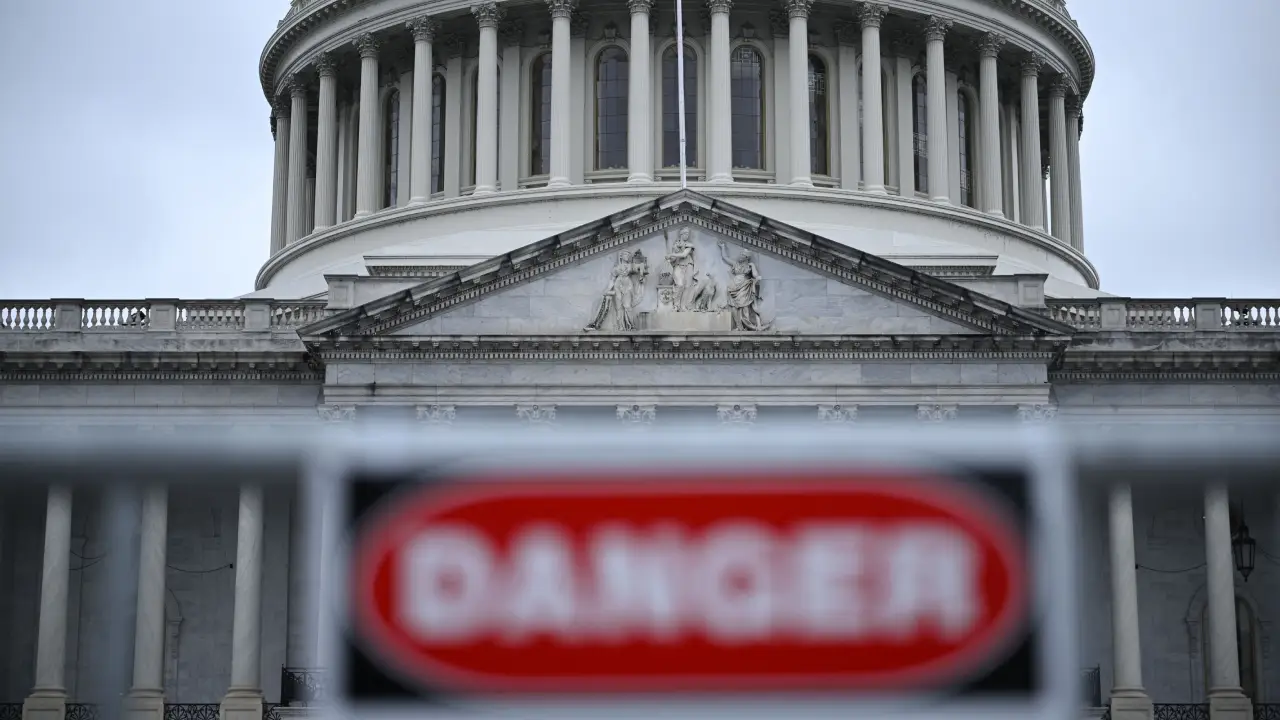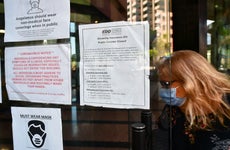Government shutdown guide: From SNAP benefits to Social Security, 8 key ways your money could be impacted

The Bankrate promise
At Bankrate we strive to help you make smarter financial decisions. While we adhere to strict , this post may contain references to products from our partners. Here's an explanation for .
Congress defied the odds and approved a measure in the eleventh hour to avert the first U.S. federal government shutdown in more than four years — ensuring that hundreds of thousands of federal workers keep getting paid and Americans can continue accessing key government services crucial to their personal finances.
The threat, however, of a future U.S. federal government shutdown remains.
Thanks to a stopgap measure, lawmakers bought themselves 45 additional days to keep negotiating. They now have until Nov. 17 to pass the 12 annual budget appropriation bills that fund non-mandatory federal operations. If they don’t and the clock runs out, federal agencies could be forced to temporarily shutter until the impasse is resolved.
Ultimately, it was a bill that originated in the House of Representatives Saturday morning that helped the government strike a deal to remain open — a sudden and surprising turnabout. Days before a shutdown was set to begin, the Senate passed a short-term resolution of its own, a measure that experts said faced an uphill battle in the Republican-controlled House of Representatives.
Lawmakers still have a long road ahead of them. Legislators are clashing over steeper funding cuts and aid for Ukraine, with a group of conservative-leaning representatives also threatening to oust Speaker of the House Kevin McCarthy. Some members of the California Republican’s party feel the chief representative appealed to Democrats in his last-minute bid to keep the government open. The stopgap measure passed Congress by a supermajority of 335 to 91.
The ticking clock likely reminds Americans of another impasse over the summer, when the federal government risked defaulting on its debt — an unprecedented event that could’ve cascaded into a severe financial crisis and recession.
Both have the same origin story: political gridlock. Yet, they’re fundamentally different from each other. Experts say the consequences of a shutdown aren’t as catastrophic for financial markets and the broader economy. Shutdowns can still, however, cause uncertainty and pain, especially for those who feel the direct impact.
“There are no real winners in a partial government shutdown and plenty of losers,” says Mark Hamrick, Bankrate senior economic analyst and Washington bureau chief. “Some federal spending is interrupted, causing stress for government workers and contractors, as well as the many businesses tangentially reliant on those dollars, even if they aren’t paid directly by Washington.”
Here’s everything you need to know about government shutdowns, including how they could impact your finances and what consequences they could bring for the economy.
What is a government shutdown?
A U.S. government shutdown happens when Congress hasn’t agreed on a budget for a federal agency, causing the department to cease operations until the funding is approved. By law dating over a century, any non-essential department or operation that doesn’t have a budget cannot continue to spend money.
Not all government activity comes to a grinding halt. Key programs considered mandatory spending — such as Social Security or Medicare — aren’t funded through annual appropriations, meaning their funds will keep flowing. Those programs make up about 70 percent of all government spending, according to estimates from the Bipartisan Policy Center.
Rather, shutdowns impact the agencies, offices and departments funded through 12 annual appropriations bills, which span into the hundreds, according to contingency plans from the White House. Those include the Departments of Defense, Labor, Education, Commerce and more.
Departments either furlough their workers — or keep those considered essential for public health and safety on the job, just without pay. Those include active-duty military, border patrol, Transportation Security Administration (TSA) agents, air traffic control and law enforcement.
All shutdowns are partial, says Andrew Lautz, senior policy analyst for the Bipartisan Policy Center’s Economic Policy Program. But some of them are more partial than others.
That’s because agencies with a budget can remain open and operate as normal, even as swaths of the government can’t. During the previous 2018-2019 shutdown, the Departments of Defense, Labor, Health and Human Services, Education, Energy and Veterans Affairs functioned as normal because their budgets had been signed into law.
So far, both chambers of the house haven’t passed any of the 12 budgets.
Back in July, the House approved one of the 12 bills for Military Construction and Veterans Affairs, and leading up to the crucial Sept. 30 deadline, representatives also passed budgets for the Departments of Defense, Homeland Security and State. The Senate, meanwhile, hasn’t passed any bills of its own.
“No two shutdowns are the same,” Lautz says. “The one through line in a government shutdown is chaos and uncertainty.”
How long do shutdowns last?
A government shutdown lasts until Congress either agrees on a stopgap measure — or passes budget resolutions that give all federal departments funding again.
Since 1977, the federal government has shut down 14 times, all with varying durations, according to the Congressional Research Service. The average shutdown lasts about eight days, a Bankrate analysis of that data shows.
The most recent shutdown was also the longest in history, spanning 34 days between December 2018 and January 2019 under the Trump administration. Before that, the record was 21 days, beginning in December 1995 and lasting until early January 1996 under the Clinton administration.
8 key ways government shutdowns crush Americans’ finances
U.S. government shutdowns have knock-on effects that reach far beyond Washington, D.C., ranging from a minor inconvenience at best — to a severe disruption to the services vital for Americans’ daily lives, at worst. That’s especially true when it comes to their finances.
National parks close; travelers could face longer lines at airports. Some federal workers refused to report to work without pay during the 2018-2019 shutdown. Facing a leaner staff, airports had to close security checkpoints. The workers who keep working take on more with less, meaning typical day-to-day tasks could take longer.
Some agencies, meanwhile, are allowed to carry funds over from previous fiscal years into the new ones, though those funds risk running dry the longer a shutdown persists.
1. Paychecks for federal workers
Federal workers employed at one of the agencies without a budget feel the biggest impact in a government shutdown. Their paychecks are put on hold — even if they’re deemed essential and have to keep working. The only exception are members of Congress, who continue to get paid and are not subject to furlough, according to the Congressional Research Service.
Government agencies draft contingency plans to decide who’s job is essential and who gets furloughed. Back in 2019, the Congressional Budget Office estimated that roughly 800,000 of the 2.1 million federal workers worked for an agency that lacked an approved budget. Nearly 300,000 of them were furloughed.
The amount of workers impacted depends on how many individual department budgets Congress has passed, Lautz says. The previous shutdown began with five of the 12 bills already passed — making up some 70 percent of all discretionary spending.
Meanwhile, federal government employment has grown 4.9 percent since the 2018-2019 shutdown, data from the Labor Department shows.
“It was only a relatively small slice of the government pie that was shut down,” Lautz adds. “We would expect a shutdown to be broader and have broader impacts on the economy.”
Under the Government Employee Fair Treatment Act of 2019, federal workers are guaranteed their lost wages in back pay. Workers must be made whole “on the earliest date possible, regardless of scheduled pay dates,” the law states.
Yet, federal workers aren’t the only ones doing business with the government. Government contractors’ jobs go on pause if they’re working for a department that doesn’t have a budget. Their back pay isn’t guaranteed, meaning they may never be able to recoup their wages.
2. Social Security, Medicaid and Medicare benefits
Even though a shutdown wouldn’t disrupt the flow and delivery of Social Security, Supplemental Security Income (SSI), Medicaid or Medicare benefits, recipients could still feel an impact.
The Social Security Administration currently plans to furlough about 14 percent of its employees in a shutdown, while the Centers for Medicare and Medicaid Services within the Department of Health and Human Services plans to retain 49 percent of its staff, their contingency plans show.
Previous shutdowns have hit Medicare recipients hard, though it’s unlikely to be as severe in a future shutdown, the Committee for a Responsible Federal Budget states. Back in the 21-day 1995-1996 shutdown, more than 10,000 Medicare applicants were temporarily turned away each day during the shutdown.
In a shutdown, the agency plans to keep issuing new and replacement Social Security cards and accepting applications for Social Security benefits. But other activities will be put on pause, including the processing of overpayments or replacing of Medicare cards.
3. Food assistance programs such as the Supplemental Nutrition Assistance Program (SNAP) and aid for Women, Infants and Children (WIC)
A government shutdown could threaten the livelihoods of millions of Americans who rely on the Department of Agriculture’s Supplemental Nutrition Assistance Program (SNAP) and Women, Infants and Children (WIC). Those programs are managed by the Department of Agriculture, whose budget must be approved annually.
SNAP is considered a mandatory program, while WIC funding comes from discretionary spending. But the Appropriations Committee doesn’t provide these entitlement programs with the same protections as Medicare or Social Security, according to the Center for Budget and Policy Priorities.
The department plans to continue disbursing SNAP and WIC payments during the shutdown, but without any federal money coming in, it’ll rely on other funds and cash reserves from previous years, its contingency plan shows. The longer the shutdown persists, the more those programs are at risk of running dry.
As threats of an Oct. 1 shutdown grew, Agriculture Secretary Tom Vilsack indicated the SNAP program could sustain itself for a few weeks, while contingency funds for WIC could dry up within “a day or two.”
Almost 7 million people utilizing WIC could see disruptions and go without benefits if the government shuts down, the Biden administration also warned.
4. Tax refunds, credits and other services
Shutdowns have been known to delay tax credits and refunds. Filings also aren’t processed as quickly. That could especially impact Americans who filed with a paper return to meet the Oct. 16 tax extension deadline.
In 2013, billions of dollars of tax refunds were delayed, according to the Committee for a Responsible Federal Budget. A backlog of 1.2 million income and Social Security number verification requests also delayed mortgage and other loan approvals.
Fewer workers at the Internal Revenue Service (IRS) would likely be able to keep working than originally assumed. The agency planned to use funds from the Inflation Reduction Act (IRA) to keep the agency’s nearly 90,000 employees employed and paid, a now-archived page from the IRS’s contingency plans show. Yet, an updated playbook released on Sept. 27 shows just 33 percent will continue to work and get paid. Some of the services the agency would put on pause include tax return audits and call-in services for taxpayers who have questions outside of the filing season, those new plans show.
At least 26,000 furloughed IRS employees were called to return to work during the 2018-2019 shutdown ahead of tax season, but 14,000 didn’t show up without pay, according to reporting at the time from ABC News.
5. Unemployment benefits
The 1.7 million Americans utilizing unemployment insurance (UI) for income as of Sept. 16 would still continue receiving payments through the joint federal-state program. But about 73 percent of the Department of Labor’s staff will be furloughed, according to the Department’s plans updated Saturday. Processing delays and administrative hurdles could be possible.
Federal employees are eligible to apply for unemployment benefits the day they go on furlough, but those who keep working on a full-time basis are generally not eligible, according to the Office of Personnel Management. Those payments, however, will likely need to be repaid when your back pay comes in.
6. Student loans
Americans who are making payments on their student loans for the first time in more than three years may have trouble getting their questions answered. The Office of Federal Student Aid plans to keep just 17 percent of its employees on board during a shutdown, according to its contingency plans for the current fiscal year. The ripple effect could result in longer wait times and delays.
Pell Grants and student loans would continue to be paid, but a shutdown longer than one week could “severely curtail” aid to school districts, universities, colleges and other educational institutions.
The Department of Education would also pause most of its grantmaking activities, discontinuing awards and application reviews, the department said.
7. Interest rates and the Federal Reserve
A government shutdown could interrupt the flow of data to the U.S. central bank at a crucial time.
Officials in September signaled that they’re expecting to lift interest rates once more this year in their quest to defeat the hottest inflation in 40 years, which could happen at either the Fed’s November or December meeting. But Fed Chair Jerome Powell has stressed for months now that the Fed wants to be “data dependent” when deciding whether to raise interest rates any more.
In a shutdown, Fed officials would be flying blind. Key departments producing the economic data Fed officials rely on when deciding how much to raise interest rates would be completely shuttered in a shutdown. That includes the Department of Labor’s Bureau of Labor Statistics, as well as the Department of Commerce’s Bureau of Economic Analysis. Those agencies publish monthly jobs and inflation reports, as well as snapshots of broader economic growth, including gross domestic product (GDP).
If a Nov. 17 shutdown occurs, Fed officials might not be able to take a look at the November employment report released Dec. 8, depending on how long the shutdown lasts. A look at inflation in November that’s scheduled to be released on Dec. 12 could also be delayed. A look at GDP for the third quarter of 2023 released Nov. 29 could also be delayed, while the Department of Commerce’s planned Nov. 30 release of the Fed’s preferred inflation gauge — the personal consumption expenditures index (PCE) — could be in jeopardy.
During a 16-day partial shutdown in 2013, the Bureau of Labor Statistics wasn’t able to publish its September employment report until Oct. 22 — more than two weeks after its original date. CPI was published on Oct. 30.
It’d be a troubling time for officials to be flying blind. Price increases have slowed, but overall inflation has heated up from a year ago for two straight months. Gasoline prices have been popping, contributing to more than half of the August gain in inflation. The United Auto Workers (UAW) strike also risks pushing up prices on vehicles. At the same time, the return of student loan payments could take some steam away from consumer spending.
Fed officials would be concerned if those shocks contributed to a sustained pickup in inflation, but they won’t be able to tell if it’s happening without their reports.
“The Fed may end up being more patient and cautious as it assesses the economy,” says Jeffrey Roach, chief economist for LPL Financial. “The unknown economic impact of a shutdown will likely keep the Fed from altering interest rate policy.”
8. The broader economic impact
The 34-day shutdown between 2018-2019 erased $11 billion in economic output, according to research from the Congressional Budget Office. About $8 billion was later recovered, but $3 billion was permanently drained. A larger shutdown could result in an even bigger hit.
Each week the federal government is shut down would amount to a 0.2 percentage point drag on GDP, according to estimates from Brusuelas.
“Given the recent number of government shutdowns, we are confident that the economic impact will be modest and would push a small portion of economic activity into the first quarter,” Brusuelas says.
Bottom line
A shutdown is the definition of an emergency, unexpected expense. Americans have no control over it, and many are left suffering financially.
Still, a possible shutdown comes at a crushing time for Americans’ finances, already reeling from high interest rates and inflation. More than 1 in 5 Americans (or 22 percent) have no emergency savings at all, the second lowest percentage in 13 years of polling, according to a Bankrate survey from June.
“A shutdown can be a slow-moving crisis,” he says. “Sometimes, it takes a couple days or a week or two for the ripple effects to really start to take a toll on the economy. They are damaging every day to the economy and to the federal government. They waste resources, no matter how short they are.”
Related Articles


Unemployment benefits: 8 possible reasons your payment is late — and what to do about it

